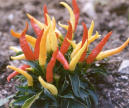
Growing Chile Peppers

| HOME | Pictures | Growing | Hot Sauces | Recipes | History | Medicinal Use | Links | Sources | |

|
Growing Chile Peppers |

|
|
Easy to grow. Five-six plants should provide plenty of peppers once established. Peppers are sensitive to cold, and so are often grown in temperate regions, but they can be grown anywhere with a warm growing season. In colder regions, peppers seeds should be sown indoors, in containers, in the spring. They need to be in an environment where the temperature is at least 64 degrees farenheit (18 degrees celcius). Start peppers about 8 weeks before you plan to move them outside. In late spring or early summer, when the temperatures are warm enough outside, the seedlings can be moved outside and transplanted. Plant seeds about 1/2 an inch deep, and 24 inches apart in each row. Leave about 30 inches between rows. Note, chile peppers cross-pollinate easily, so your pepper plants should be separated by variety and you should keep some space between varieties. Peppers can also be kept in containers year-round. The containers can be moved outside when it is warm, and moved back inside when the temperature drops. This is a good solution if you want to keep your peppers through the winter. However, they won't produce much during the winter months. Soil should be well-fertilized, but not too rich in nitrogen. Use moderate amounts of mature compost humus. The soil should also have good drainage. If gardening in pots, you want containers made of a material that is porous, to enhance drainage. Mature plants like plenty of sun, but may still need a little shade on especially hot days. Young plants do better with partial sunlight. Water frequently enough to keep plants from wilting. However, if you water too much, you are apt to produce milder peppers. Once plants have flowered, feed twice.
For my money, your best bet in dealing with pest problems is to employ organic gardening techniques, and intercrop plants in your garden. Peppers can be planted in with carrots and onions, in the same row. With plants intercropped, there is less opportunity for a bad pest outbreak, and pests from one plant may be predators for pests that favor another, keeping populations in check. Soil health is key, as it makes for healthier, more disease resistant, plants. |
| HOME | Pictures | Growing | Hot Sauces | Recipes | History | Medicinal Use | Links | Sources | |